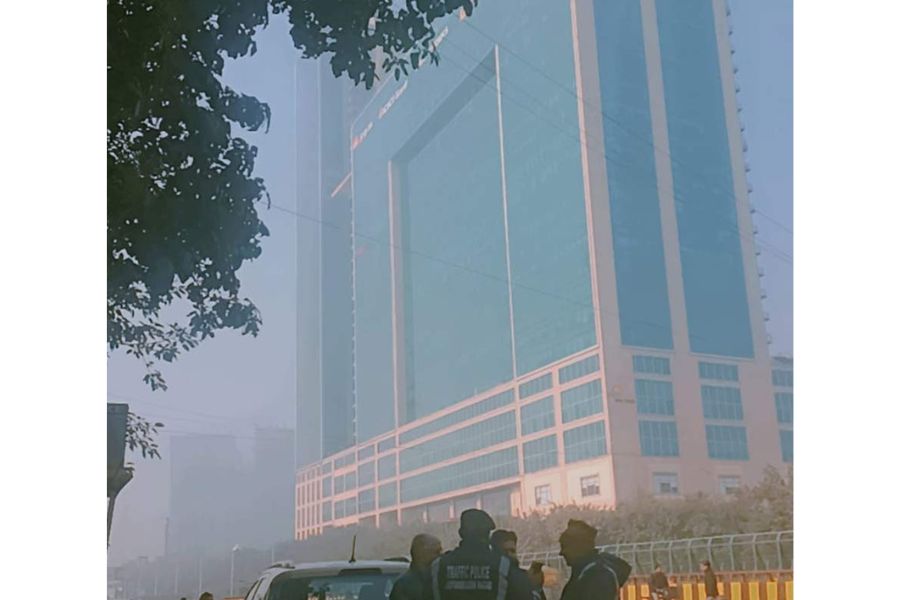Posing as CBI and RBI officials, suspected cybercriminals recently put a retired banker and his wife under "digital arrest" for five days in Uttar Pradesh's Meerut district and convinced the elderly couple to transfer more than Rs 1 crore to them.
A senior doctor from Lucknow's SGPGIMS lost Rs 2.81 crore under a similar ruse in August while reports of such crimes have also emerged from Noida and Varanasi, among other places in the state.
Cybercrimes, particularly digital arrests and financial frauds under the pretext of investment or employment, have surged since the COVID-19 pandemic. Prime Minister Narendra Modi also warned citizens about these threats during a recent "Mann ki Baat" address.
Subject experts explain that digital arrest refers to a deceptive tactic used by cybercriminals, who falsely claim to have the authority to arrest an individual through digital means, often over the phone or via online communication.
Scammers pose as law enforcement or regulatory officials and use threats or intimidation to coerce victims into transferring money or providing personal information, claiming that they are involved in illegal activities. This method exploits fear and confusion, taking advantage of the victim's panic to facilitate financial fraud.
"I was told by the callers they were from the CBI (Central Bureau of Investigation) and that my name had cropped up in a money-laundering and a human trafficking case, for which I would be arrested. They told me that to avoid arrest, I would be put under digital arrest while they examined my documents online," the Sanjay Gandhi Postgraduate Institute (SGPGI) of Medical Sciences doctor said in her complaint.
"I was asked not tell anyone about it since it was a matter of national importance," the Lucknow-based doctor said.
According to data from the Uttar Pradesh Police, compiled by the non-profit Future Crime Research Foundation, more than 38.85 lakh calls were registered by the National Cyber Crime Reporting Portal between January 2022 and August 2024, with over 6.05 lakh (15.7 per cent) originating from Uttar Pradesh.
Remarkably, 84.53 per cent of these calls related to financial fraud, amounting to Rs 3,153 crore, while nationwide figures reached Rs 19,860 crore.
Triveni Singh, a former Indian Police Service (IPS) officer and cybercrimes expert, explained that the criminals behind these digital arrests operated from three fronts -- bogus call centres in India, Pakistan, and a combined region of Cambodia, Myanmar and Laos in south Asia.
"In Cambodia, Myanmar and Laos, there is a disturbing trend known as cyber slavery. Gangs recruit unsuspecting individuals under the guise of offering jobs at call centres, only to coerce them into committing cybercrimes," Singh, formerly a superintendent of police for UP Cyber Crime, noted.
These criminals typically claim to be from the Enforcement Directorate (ED) or the CBI, allege that the victim's personal details are linked to illicit activities such as drug trafficking or money laundering. In some cases, the victims are falsely accused of viewing pornography, causing them to panic and comply.
Singh emphasised that there was no legal basis for digital arrest in India or anywhere else.
"If anyone threatens you with virtual arrest via Skype or any other means, consider them as fraud," the "Cyber Singham" cautioned.
Identifying the challenges faced by law enforcement, Singh highlighted that most fraudulent calls were made via VoIP through messaging apps such as WhatsApp.
This complicates the tracing of calls as obtaining data from these platforms, which often have servers outside India, is both challenging and time-consuming.
The rising volume of cybercrimes makes it difficult for the police to respond quickly and, by the time information is gathered, the money is often funnelled into multiple accounts or converted into cryptocurrency.
Superintendent of Police (UP Cyber Crime) Rajesh Kumar Yadav echoed the need for public awareness, noting that while financial fraud cases had surged, reported incidents of digital arrests remained relatively low -- around 10 cases in total.
Uttar Pradesh has a robust call centre system for reporting cybercrimes, with the helpline 1930 integrated with UP 112, allowing victims to report cybercrimes quickly. The website cybercrime.gov.in enables immediate reporting of cyber fraud, ensuring prompt action, he said.
Yadav also pointed to the crucial role of the victims. "The sooner you recognise a fraud and report it, the better the chances of recovering lost funds." He outlined two primary reasons individuals fall prey to such scams -- greed and fear.
Greed often stems from promises of easy money through investments or work-from-home opportunities while fear is manipulated through leaked personal information.
Both Singh and Yadav stressed that no legitimate law enforcement inquiry occurred online or through video calls.
"However, cybercriminals continuously devise new methods. Raising awareness among citizens is vital for combating these crimes," Yadav said.
He added that the Union Home Ministry operated a social media channel -- "Cyber Dost" -- to disseminate information about emerging fraud tactics.
The senior officer said the ministry, along with its specialised agency I4C, regularly conducted training sessions to enhance the capabilities of cyber personnel in Uttar Pradesh and other states.
Except for the headline, this story has not been edited by The Telegraph Online staff and has been published from a syndicated feed.











